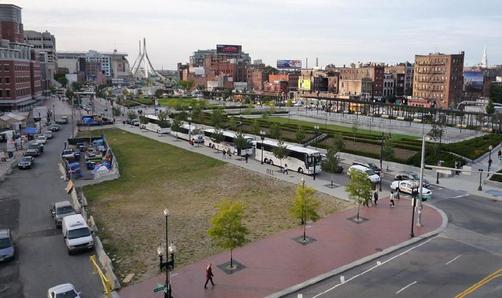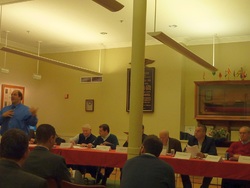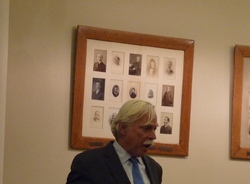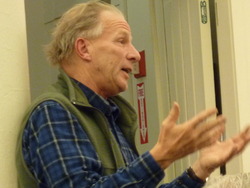
What did we learn this week at the fourth MassDOT Parcel 7 & 9 RFP Advisory Committee meeting? The good news is that the process is moving to Stage 2 (Ed: feels like Stage 22) which brings it out of the philosophical thinking stage into a more practical, decision stage. The bad news is a lack of consensus on the type of structure that should be developed.
Members of the RFP Advisory Committee, along with developers and MassDOT are struggling with these parcels. They are tough spots with many conflicting factors. The needs of the intended ground floor public/local markets are raising many questions about what can otherwise exist on the lots.
MassDOT’s Peter O’Connor set the stage by stating that the purpose of this meeting is to have an open exchange between the Advisory Committee and the attending public, including past bidders and prospective developers.

The final goal of this committee is to draft RFP guidelines that will result in a successful project, with general community acceptance. MassDOT defines a successful project as one that is developed quickly and activates the Greenway.
Meeting the goals of a “Market District” was a repeated theme. Peter Gori of the Boston Redevelopment Authority encouraged all interested parties to read the Market District Feasibility Study to learn more about what make markets work. A future, more intense study is being considered by the BRA.
Committee member, Dan Nuzzo, asked to hear what would excite developers to provide a successful project that would meet the desired community benefits.
Dave Roderick, a North End resident and long-term observer of this process, suggested that student residences be considered. The previous apartment proposal by Eastat Realty was rejected by the Haymarket Pushcart Association and MassDOT because apartments were viewed as incompatible with the marketplace. However, students would care less about the noise and smells. As users of public transportation, they also don’t need parking. An active 24/7 student population would activate the Greenway. Lastly, Roderick pointed out that students are crowding out residents in the North End and Beacon Hill. If they had more designated housing, these neighborhoods might be more affordable to families and other non-student residents. With that said, Roderick is still a supporter of a small-scale 2-story market, similar to Quincy Market.

Frank O’Keefe of the Boston Museum brought an extensive team to the meeting to make their case for a civic use. The Museum’s concept hasn’t changed significantly from their proposal last year, although they also want to use Parcel 7 for expansion space. O’Keefe makes the point that the return to the State is very low regardless of use, so why not designate a non-profit for greater public benefit? With an original plan for 82’ in height, the Museum believes any project would need to exceed the 55’ limit.
Committee member Victor Brogna asked, “What would you do with Blackstone St.?” Mr. O’Keefe responded they would work with the pushcart vendors to upgrade the historic block. Ann Fanton, a part-time Beacon Hill resident, said she did not want to lose sight lines to Blackstone Street.
If designated, the Museum would ask for three years to raise money for the Parcel 9 development. In the meantime, they would bring in partners to operate Parcel 7. When asked about their existing designation on Parcel 12, Mr. O’Keefe said the cost premium to build over the ramps was not feasible. Committee member Bob O’Brien noted that all civic, non-profit designations have failed to move forward on the Greenway (New Center, YMCA).

Developer Philip DeNormandie said the Museum proposal ignores the most significant street in Boston, Blackstone street, where he owns several properties. He noted that the City has re-zoned the area as a market district. As the owner of a Massachusetts beef cattle farm, he said, “selling local beef is difficult and farmers desperately need a market.”
Believing the unique parcels can be used for public benefit, he said, “there is nothing wrong with a two-story building. Developers don’t need to make a killing on every project. A Museum could be located anywhere. This is not the right spot.”
Bob O’Brien said he liked Mr. DeNormandie’s previously proposed concept of incorporating his properties on Blackstone St. into the Parcel 9 project. But he asked, “Why haven’t you improved those properties in the past?” Mr. DeNormandie answered that he has renovated many of his Union Street properties but has been waiting for the Greenway to take form before doing much on Blackstone Street. He also noted long-term tenants in the Blackstone St. buildings.
Lastly, Mr. DeNormandie made a case for a canopy over Blackstone St. to form a year-round market block. The BRA’s Peter Gori said the Landmark Commission is unlikely to allow such modifications to a historic district.
Committee member Tad Stahl said he wants to strengthen the market district and there are too many things we don’t know. It was noted that the Boston Public Market Association, the favored non-profit to run the Parcel 7 market, has not been participating in any of these meetings. Mr. Gori again asked the committee to read the Market District Feasibility Study.
A representative of the Haymarket Pushcart Association spoke against residential housing due to the inherent conflict with the noise and smells of the market. He facetiously asked for three years to raise money to build a 2-story market, referencing the Boston Museum’s request. He noted that much of Parcel 9 is already being used as the back-end of Haymarket. These needs would increase with a larger market district.
Bill Caulder, Gutierrez Company representative and North End resident, said he thought bidders would need certainty in the RFP as to what the ground floor market was going to entail. He was not sure if his company would bid given the drop in office rents ($36/sf estimated versus $52/sf a few years ago). He agreed with others that the use of Parcels 7 and 9 could be combined for a coherent project.
Faneuil Hall Marketplace representative, Dr. Claudio Kraus, said that North End people have been through a lot with the Big Dig. If the community would benefit from a low-rise, market structure, he thought the committee should seriously consider that option.
There are six more meetings planned toward the creation of a RFP. The next meeting will be held in January 2011. MassDOT’s community liaison John Romano noted the State’s agriculture commissioner is expected to present at the next meeting.
Correction: In the post on the Third RFP Advisory Committee meeting, a quote from committee member Victor Brogna was incorrect. The correction is shown below.
Reading an excerpt from the Boston 2000 Plan, Mr. Brogna makes the case for reconnecting the Blackstone Block to the North End. According to the DOT document, “Parcels 8, 9 and 10 form a critical link between the North End and the Blackstone Block, and reestblish a street and block pattern that was broken by construction of the elevated Central Artery. The design of these parcels should place landscaping materials and any structures in a way that maintains and enhances views between the Blackstone Block and the North End along Hanover, Salem and North streets, and encourages pedestrian safety.”




The Boston Museum project needs to give up gracefully. They have been trying to do this project in different locations, including City Hall Plaza before the big dig stlarted. They have NEVER been able to raise the money or sufficient public support for this project. Time to move on people.
Dave Rodericks idea of student housing is never going to happen. It is not a very appealing anyway. Do we really want an unchaperoned all student Animal House ghetto in the area?